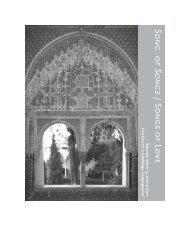BH1001, Guillaume Du Fay: Motets - Blue Heron
BH1001, Guillaume Du Fay: Motets - Blue Heron
BH1001, Guillaume Du Fay: Motets - Blue Heron
Create successful ePaper yourself
Turn your PDF publications into a flip-book with our unique Google optimized e-Paper software.
8<br />
between discantus and tenor, while in Par<br />
droit je puis bien complaindre the complaining<br />
upper voices sing a canon at the unison. In Par<br />
droit the usual three-voice chanson scoring is<br />
expanded to four, the two texted cantus parts<br />
supported by two untexted contratenors. Mon<br />
cuer me fait tous dis penser, too, is written in four<br />
parts, all supplied with text.<br />
Much of the poetry of the fifteenth-century<br />
chanson may strike modern readers as undistinguished<br />
or stilted—its formal rhetoric of impossible-to-translate<br />
words like courtoisie and gentillesse<br />
difficult for us to penetrate, its endless<br />
repetition of a few bland adjectives (beau, doux)<br />
evoking little emotional response, its allegorical<br />
characters (Fortune, Vray Espoir, Dangier, Male<br />
Bouche, and so on) unfamiliar—but if we find<br />
these texts difficult to appreciate, perhaps we<br />
ought to ask what it was that the composers<br />
themselves may have appreciated in the<br />
poems that they set to such wonderful music.<br />
Besides intensity of feeling, however conventionally<br />
expressed, surely musicians valued the play<br />
of sounds in poems like J’atendray tant qu’il vous<br />
playra, with its rhymes “playra,” “desplayra,” and<br />
“complaire a,” or punning like that on the word<br />
“pieur” (“drinker” or “worst”) in Puisque vous estez<br />
campieur. These are texts for singing, song lyrics,<br />
where sonic pleasure and playful allusiveness<br />
are more to the point than sophisticated syntax<br />
and metaphor. 5 While most of the poems speak<br />
of unrequited love or the superlative qualities<br />
of the unattainable lady, there are occasional<br />
exceptions like the drinking song Puisque vous<br />
estez campieur. Mon cuer me fait tous dis penser<br />
contains an acrostic, Maria Andreasq[ue], so may<br />
commemorate the marriage of an unidentified<br />
couple called Maria and Andreas. A more ravishingly<br />
beautiful wedding song can hardly be<br />
imagined. Here, too, a simple delight in the<br />
sound of words is apparent: “penser” is inverted<br />
to “sans per,” “amer” (to love) is echoed by “amer”<br />
(bitter). How pleasing to mouth and ear is the line<br />
“Jone, gente, blanche que lainne,” which freely<br />
mixes alliteration and internal vowel rhyme in<br />
its series of syllables closed by some form of “n.”<br />
Texts like this are much closer to pop lyrics than<br />
high poetry, and may be compared to the following<br />
outstanding twentieth-century example:<br />
Lovely Rita meter maid,<br />
May I inquire discreetly,<br />
When are you free<br />
To take some tea with me?<br />
Amid chanson lyrics, Malheureulx cueur, by the<br />
French court poet Le Rousselet, seems to speak<br />
with unusual psychological acuity. The speaker<br />
asks his own heart why it persists in causing him<br />
such pain by its stubborn insistence on loving<br />
a woman who does not return the feeling. <strong>Du</strong><br />
<strong>Fay</strong>’s chanson is heartbreaking. Note how the<br />
expressive fluidity of modal harmony, so different<br />
from the goal-directed, heirarchical orientation<br />
of tonal harmony, conveys shifts of mood as it<br />
moves from the expansive “C-major” sonorities



